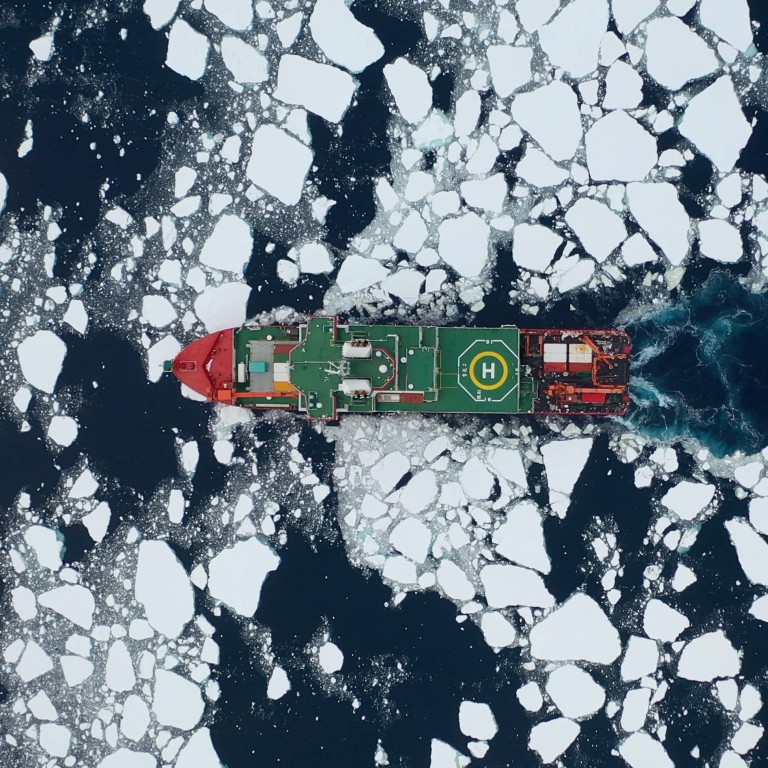
Hong Kong to receive icebreaker Xue Long 2 for first time in April; visit kicks off 5-day showcase of nation’s scientific achievements
- Xue Long 2, China’s first domestically built polar scientific research icebreaker, will arrive on April 8
- Quota of 3,000 people can visit the vessel free of charge at the Ocean Terminal in Tsim Sha Tsui from April 9 to 12
The Xue Long 2 icebreaker will visit Hong Kong for the first time next month, with a range of activities slated across its five-day stay aimed at teaching the public about the nation’s achievements in polar scientific research.
Xue Long 2, the country’s first domestically built polar scientific research icebreaker, will arrive on April 8. A quota of 3,000 people can visit the vessel free of charge at the Ocean Terminal in Tsim Sha Tsui from April 9 to 12.
Visitors can apply for a slot via online registration that will put hopefuls through a balloting process due to the limited capacity on the ship. The registration process will open at 11am next Tuesday, and residents can do so through the mobile app uutix, according to organisers.
Professor Ho Kin-chung, founder of the Green Future Foundation Association and the Polar Research Institute of Hong Kong, both event organisers, said this was a significant year for Xue Long 2, as it completed China’s 40th Antarctic expedition and supported the construction of the Qinling Station in the Antarctica’s Ross Sea earlier this year.
“The significance of the visit is that Hong Kong is the first Chinese port it returns to when it comes home, which gives us Hongkongers a strong sense of identity,” Ho said.
“We, Hongkongers, are proud of the Xue Long 2, which is China’s contribution in Arctic and Antarctic research to the world,” he said, adding the visit by the icebreaker and the delegation would also facilitate scientific exchanges and help the city’s development into a maritime centre.

Ho added that a lavish ceremony involving two helicopters, a fleet of vessels and buses, as well as a line-up of performances and sharing sessions by scientists on April 8 will be held to welcome the icebreaker and the delegation.
Zhang Beichen, the team leader and chief scientist of China’s 40th Antarctic expedition, and captain Xiao Zhimin will also visit the city. They will be joined by a 30-member delegation that includes the country’s top polar scientists and university professors.
The icebreaker’s visit will coincide with a two-day global conference on climate change to be attended by experts worldwide, and an exhibition on the issue and polar research at the Hong Kong Science Museum starting from next Monday and lasting until June.
Students will be invited to hear from visiting scientists attached to the icebreaker as well as those at the Zhongshan Station in Antarctica, while lectures and exhibitions on polar science will also be organised for primary and secondary school students from May.
Chinese scientists look to Antarctic krill for climate change clues
Xue Long 2, which entered service in 2019 and is equipped with world-class marine and research facilities, features the world’s first dual-directional icebreaking capability at the bow and stern, and can rotate freely 360 degrees in place.
The icebreaker, which measures 122.5 metres (402 feet) long with a beam of 22.3 metres, is China’s second polar icebreaker after Xue Long.
Xue Long 2 completed its oceanic survey mission in January, marking China’s 40th Antarctic expedition. This expedition was China’s first Antarctic scientific research mission carried out by three ships working together, namely Xue Long, Xue Long 2 and the cargo vessel Tian Hui.
Researchers conducted comprehensive surveys of the hydrology, atmosphere, marine ice, biology and chemistry in the Amundsen Sea and adjacent waters during the mission.
Ho said the icebreaker would be open to some 500 to 1,000 residents a day. The visitors would be able to access five floors of the ship to view areas such as a marine sampling room and a laboratory.
China starts building icebreaker that could send experts to polar seabed by 2025
Legislator Ma Fung-kwok, who chairs the organising committee of the events, said the visit of the Xue Long 2 would help cultivate young people’s interest in scientific research and raise public awareness of environmental protection as well as polar issues.
“The visit is significant to young people who can gain a better understanding of our country through learning from the work and achievements of the icebreaker,” he said.
Organising committee member Wong Kam-leung, chairman of the Hong Kong Federation of Education Workers, said teachers and students had already expressed strong interest in the series of activities, and visits for pupils to the vessel would be organised to nurture their passion in scientific research.
“That will broaden students’ horizons, and enable them to have an updated understanding of the country’s latest scientific research achievements,” he said.

